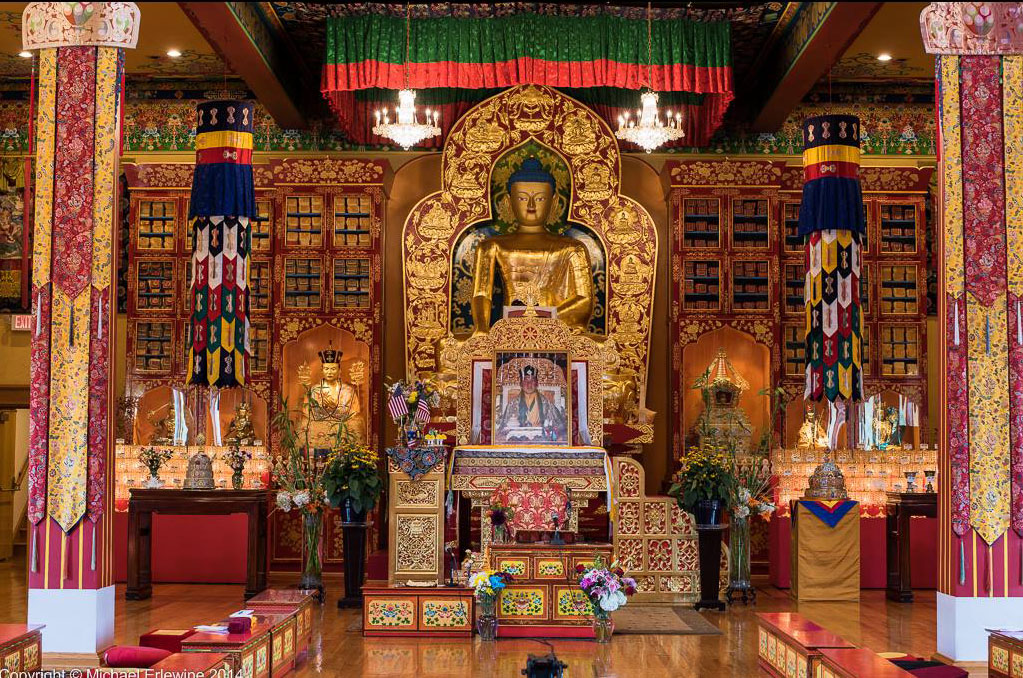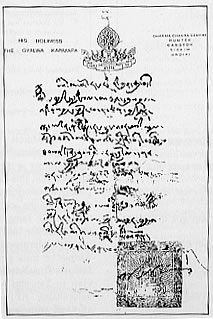By Jennie Mullen

Introduction
Karma Triyana Dharmachakra (KTD) is a Tibetan Buddhist monastery located in the northern Catskill Mountains above Woodstock, NY. His Holiness the 17th Gyalwang Karmapa, Ogyen Trinley Dorje, is the head of the 900-year-old Karma Kagyu Lineage of Tibetan Buddhism. The goal of KTD is to preserve Tibetan Buddhist meditation traditions and practices and make them available to the West.
History
KTD was founded by His Holiness the 16th Karmapa, Rangjung Rigpe Dorje, in 1980, one year before his death.

His Holiness believed that there were three main points as to why Buddha’s teachings are becoming relevant to Western minds. The first being, there have been specific prophecies about the Dharma flourishing and spreading from the eastern to the western hemisphere. The second point is related to changes that took place in the Land of Snow in Tibet where the Dharma was preserved, studied, understood, and realized. The last point being, His Holiness believed that through the blessings of the Three Jewels (Buddha, Dharma, and Sangha) and the great bodhisattvas, Buddha’s teachings are spreading to the West like “rays of the sun would direct its sunshine across [all the world].” During his first visit to North America, there was great interest in and enthusiasm for the teachings, particularly how they were practiced in Tibet. Due to all these factors, His Holiness decided to build a monastery for the Sangha members to perform rites and ceremonies as well as welcome anyone interested in studying the Dharma. KTD is an authentic Tibetan Buddhist monastery and was built by traditional Tibetan artists.

Through his visits to Western countries, His Holiness has interacted with and been encouraged by various spiritual leaders from Christian, Judaic, and other religious traditions to discuss making the teachings relevant to bring inner and outer peace. Specifically in North America, His Holiness visited many different churches and Catholic monasteries. He observed that in each tradition there is a basic goal to benefit others as much as possible and separate oneself from sorrow and the cause of it. Through this, His Holiness believed that there is a definite link or common understanding between Buddhist and followers of other religious traditions. It was a goal of His Holiness to share common goals of different faiths so there could be more understanding among different traditions.
“The first Karma Kagyu monastery to be establish in the United States of America is going to be here in Woodstock.” – His Holiness the 16th Karmapa
Lineage and Traditions
The Karma Kagyu Lineage is one of the four major schools in Tibetan Buddhism where Mahayana teachings are practiced. It traces its origins to Shakyamuni Buddha through Marpa who founded the Kagyu school. He traveled to India three times to bring back authentic Buddhist teachings to Tibet. Milarepa was Marpa’s most famous student who passed the teachings to Gampopa, who then passed them to the 1st Karmapa, Dusum Khyenpa, in the 11th century. This established the very first reincarnation lineage in Tibet and continues to the present day with His Holiness the 17th Karmapa. The head of the Kagyu lineage is the Gyalwang Karmapa. Karmapa means “the one who carries out buddha-activity” or “the embodiment of all the activities of the buddhas.” They have incarnated in the form of nirmanakaya, the manifestation body, for seventeen lifetimes. Karmapas are also self-recognizing meaning each incarnation leaves a prediction letter indicating where the next Karmapa will be reborn.

The Kagyu lineage emphasizes the continuity of oral practices passed from lama, master, to student. The Kagyu lineage practices sutra and tantra teaching focusing on the Vajrayana and Mahamudra teachings. The two major paths are the Path of Skillful Means and the Path of Liberation. The Path of Skillful Means is a path of tantra with four levels: the activity or action tantra, the engagement or performance tantra, intensive spiritual practice, and unsurpassed or unexcelled yoga tantra. All tantric practices contain the Development Stage, the visualization practices, and the Completion Stage, the fulfillment, perfection or dissolving practices. In the Kagyu lineage, the Development Stage is taught through tantras and yidam practices, enlightened mind manifesting in different forms of the deity. The tantric yidam practices that are unique to the Kagyu School are Vajrayogini, Cakrasambhava, and Gyalwa Gyamtso. The Completion Stage is taught to be the most sacred and profound of all tantric practice levels. The practice of Anuttarayoga Mother tantra, known as the Six Dharmas of Naropa or known in the West as the Six Yogas of Naropa, is one of the heart essences of the Kagyu lineage. It continues in all Kagyu Schools and especially in the Karma Kagyu Lineage. The Path of Liberation is the practice of the highest meditation training, Mahamudra (or the Great Seal), and the unique feature of Kagyu tradition. There are three types of Mahamudra: The Sutra Mahamudra, the Mantra Mahamudra, and the Essence Mahamudra. Instruction of all three ways is traditional in Kagyu and is emphasized in the Karma Kagyu lineage. Both tantra and Mahamudra teachings are connected to the understanding and realizing of the nature of the mind. At KTD, the goal is to promote meditation and principles of peaceful self-discipline, altruism, and compassion.
Practices and Events
The following six practices take place at KTD.
The Chenrezik puja is practiced every night except for Fridays and tsok events. Chenrezik is the embodiment of all the buddhas’ compassion and love. This Mahayana/Vajrayana puja practice includes chanting in Tibetan and English of prayers requested for those who are experiencing difficulties in life, are ill, or have died. This practice develops and enriches loving-kindness and compassion for all beings. It practices closing the distance between practitioner and the practice, so there is no difference between the practitioner and the love and compassion they are cultivating. The goal is for the practitioner to become the nature of love and compassion.
The Chod practice takes place once a month under the guidance of KTD lamas and Retreat Masters from Karme Ling. It prepares us to transform our relationship with the five aggregates to be able to sever our self-fixation of “I” or “mine” which is the cause of our suffering. In order to practice Chod, one must have received transmission and permission by a lineage-holder, but all are welcome to attend.
The Guru Rinpoche practice happens on the 10th day of the lunar calendar. It relates to Guru Rinpoche who is revered as the Second Buddha. Guru Rinpoche was an Indian tantric master credited with bringing Vajrayana Buddhism to Tibet.
The Green Tara practice happens daily at 6:00 am with chanting in Tibetan and English. This practice combines prayers and meditation to develop enlightened qualities to support peace and freedom from hardship. Green Tara is a gentle female embodiment of universal compassion. She guides us to the path of enlightenment and represents virtuous, enlightened, and miraculous activity of all Buddhas.
The Mahakala puja takes place daily. Through this practice, Mahakala appears in the form of a wrathful deity although he is not aggressive. During the ritual, one should ask for one’s negatives to be completely uplifted and that protection and guidance of enlightened beings remain inseparable until enlightenment is achieved. Only those with training and permission from their teachers can perform the chants and ritual. All are welcome to attend as a blessing.
The White Tara practice happens on special occasions and during scheduled weekend teachings and retreats. Tara is a completely enlightened Buddha who promised to appear in female form for the benefit of all beings. White Tara promotes longevity and her practice aids in attaining realization and accomplishing liberation.

I could not find much information on the demographics of KTD. There are six resident lamas and most of them were asked by His Holiness the 17th Karmapa to assist KTD. All are welcome to attend practices and events and the public seem to be very welcome. KTD also holds Zoom webcasts and shares videos on different social media platforms for anyone who wishes to participate. From all my research I get a feeling that KTD is a very welcoming community and accepts all. His Holiness is a supporter of women’s rights as well and is personally committed to ensuring women will have the opportunity to receive full ordination within the Tibetan Buddhist tradition. The community with Woodstock also seems to be strong based on the KTD official website. KTD is active with local animal shelters, food pantries, and social service programs.
KTD holds free public tours as well as access to all buildings and the Shrine Room. KTD receives its funding from group tours, yearly membership, donations, offering lamps, and retreats. Housing and overnight stays are offered to visitors as well.
Videos about the 17th Karmapa:
References:
https://kagyu.org (Official website of KTD)